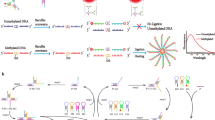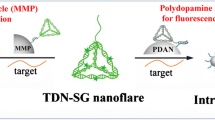Abstract
A new DNA hyperbranched hybridization chain reaction (HB-HCR)-amplified fluorescence platform combined with DNA walker was developed for versatile detection of Cu2+, adenosine triphosphate (ATP), and drug delivery to cancer cells. A novel click chemistry reaction-triggered DNA walking machine on magnetic beads (MBs) is introduced for the first time to convert target Cu2+ to lots of DNA S3 products. With the help of DNA S3 and H1 on the amino functionalized SiO2 microsphere, HB-HCR between super hairpin DNA (SH DNA), H3-DNA, and LT-DNA was initiated to assemble a novel dendritic DNA structure with numerous fluorescent Cy5, achieving enormously amplified signal for ultrasensitive detection of Cu2+. Furthermore, this contains large amounts of double-stranded DNA with plentiful GC bases, which can provide many loading sites for chemotherapeutic drug doxorubicin (Dox). The specific binding of ATP to aptamer in the dendritic DNA structure allows for release of Dox, leading to activation of Dox fluorescence for ATP assay. More importantly, this dendritic DNA nanostructure-loaded Dox enters into tumor cells by endocytosis, and then interacts with endogenous ATP, releasing Dox for efficient treatment of cancer cells. Taking advantages of these multiple amplification of HB-HCR on SiO2 microsphere, click chemistry reaction, DNA walking, and release of Dox, this method enables ultrasensitive detection of Cu2+ and ATP as low as 0.1 fM and 1.0 aM, respectively, which can be widely used for accurate detection of biomolecules in clinical diagnosis and biomedical applications. This dendritic DNA nanostructure provided an effective tool for designing smart nanodevices.

Graphical abstract











Similar content being viewed by others
References
Willis MS, Monaghan SA, Miller ML, McKenna RW, Perkins WD, Levinson BS, Bhushan V, Kroft SH (2005) Zinc induced copper deficiency: a report of three cases initially recognized on bone marrow examination. Am J Clin Pathol 123:125–131
Robinson NJ, Winge DR (2010) Copper metallochaperones. Annu Rev Biochem 79:537–562
Klevay L M (1997) Copper as a supplement to iron for hemoglobin building in the rat (Hart et al., 1928). J. Nutr
Lawrence C, Sanders GE, Aquatics WC (2018) Management of animal care and use programs in research, education, and testing, 2nd edn. CRC Press/Taylor &, Francis
Merian E (1991) Metals and their compounds in the environment. Weinheim, VCH
Lan G-Y, Huang C-C, Chang H-T (1257) Chem Commun 2010, 46
Llaudet E, Hatz S, Droniou M, Dal N, Llaudet E, Hatz S, Droniou M, Dale N (2005) Microelectrode biosensor for real-time measurement of ATP in biological tissue. Anal Chem 77:3267–3273
Wang J, Jiang YX, Zhou CS, Fang XH (2005) Aptamer-based ATP assay using a luminescent light switching complex. Anal Chem 77:3542–3546
Deng JJ, Wang K, Wang M, Yu P, Mao LQ (2017) Mitochondria targeted nanoscale zeolitic imidazole framework-90 for ATP imaging in live cells. J Am Chem Soc 139:5877–5882
Eguchi Y, Shimizu S, Tsujimoto Y (1997) Intracellular ATP levels determine cell death fate by apoptosis or necrosis. Cancer Res 57:1835–1840
Ge CC, Luo Q, Wang D, Zhao SM, Liang XL, Yu LX, Xing XR, Zeng LW (2014) Colorimetric detection of copper (II) ion using click chemistry and hemin/G-quadruplex horseradish peroxidase-mimicking DNAzyme. Anal Chem 86:6387–6392
Yin B, Ye B, Tan W, Wang H, Xie C (2009) An allosteric dual-DNAzyme unimolecular probe for colorimetric detection of copper (II). J Am Chem Soc 131:14624–14625
Etienne M, Bessiere J, Walcarius A (2001) Voltammetric detection of copper (II) at a carbon paste electrode containing an organically modified silica. Sensors Actuators B Chem 76:531–538
Yantasee W, Hongsirikarn K, Warner CL, Choi D, Addleman RS, Timchalk C (2008) Direct detection of Pb in urine and Cd, Pb, Cu, and Ag in natural waters using electrochemical sensors immobilized with DMSA functionalized magnetic nanoparticles. Analyst. 133:348–355
Guo YS, Liu J, Yang GX, Sun XF, Chen HY, Xu JJ (2015) Multiple turnovers of DNAzyme for amplified detection of ATP and reduced thiol in cell homogenates. Chem Commun 51:862–865
He F, Wang J, Yin B, Ye B (2018) Quantification of exosome based on a copper-mediated signal amplification strategy. Anal Chem 90:8072–8079
Li F, Wang J, Lai YM, Wu C, Sun SQ, He YH, Ma H (2013) Ultrasensitive and selective detection of copper (II) and mercury (II) ions by dye-coded silver nanoparticle-based SERS probes. Biosens Bioelectron 39:82–87
Shen QP, Li W, Tang S, Hu Y, Nie Z, Huang Y, Yao S (2013) A simple “clickable” biosensor for colorimetric detection of copper (II) ions based on unmodified gold nanoparticles. Biosens Bioelectron 41:663–668
Yang C, Chen K, Chen M (2019) Nanoscale metal–organic framework based two-photon sensing platform for bioimaging in live tissue. Anal Chem 91:2727–2733
Devadoss A, Chidsey CED (2007) Azide-modified graphitic surfaces for covalent attachment of alkyne-terminated molecules by “click” chemistry. J Am Chem Soc 129:5370–5371
Gao XS, Li HK, Zhao Y, Jie GF (2019) Triple-helix molecular switch-based versatile “off-on” electrochemiluminescence and fluorescence biosensing platform for ultrasensitive detection of lipopolysaccharide by multiple-amplification strategy. Biosens Bioelectron 143:111602
Wang H, Li C, Liu X, Zhou X, Wang F (2018) Construction of an enzyme-free concatenated DNA circuit for signal amplification and intracellular imaging. Chem Sci 9:5842–5849
Wu J, Li N, Yao Y (2018) DNA-stabilized silver nanoclusters for label-free fluorescence imaging of cell surface glycans and fluorescence guided photothermal therapy. Anal Chem 90:14368–14375
Chu Y, Deng A, Wang W (2019) Concatenated catalytic hairpin assembly/hyperbranched hybridization chain reaction based enzyme-free signal amplification for the sensitive photoelectrochemical detection of human telomerase RNA. Anal Chem 91:3619–3627
Bi S, Chen M, Jia X, Dong Y, Wang Z (2015) Hyperbranched hybridization chain reaction for triggered signal amplification and concatenated logic circuits. Angew Chem Int Ed 54:8144–8148
Xuan F, Fan TW, Hsing IM (2015) Electrochemical interrogation of kinetically-controlled dendritic DNA/PNA assembly for immobilization-free and enzyme-free nucleic acids sensing. ACS Nano 9:5027–5033
Schüller VJ, Heidegger S, Sandholzer N (2011) Cellular immunostimulation by CpG-sequence-coated DNA origami structures. ACS Nano 5:9696–9702
Hu Y, Chen Z, Zhang H, Li M, Hou Z, Luo X, Xue X (2017) Development of DNA tetrahedron-based drug delivery system. Drug Delivery 24:1295–1301
Zhang Y, Huang F, Ren C (2017) Targeted chemo-photodynamic combination platform based on the DOX prodrug nanoparticles for enhanced cancer therapy. ACS Appl Mater Interfaces 9:13016–13028
Qiu L, Chen T, Öcsoy I, Yasun E, Wu C, Zhu G, You M, Han D, Jiang J, Yu R, Tan W (2015) A cell-targeted, size-photocontrollable, nuclear-uptake nanodrug delivery system for drug-resistant cancer therapy. Nano Lett 15:457–463
Jin LH, Han CS (2014) Ultrasensitive and selective fluorimetric detection of copper ions using thiosulfate-involved quantum dots. Anal Chem 86:7209–7213
Xiong YM, Meng PJ, Li HL, Hu Y, Zhou LH, Jiang SQ, Pang YF, Li SJ, Huang PL (2018) Dual signal amplification strategy for high-sensitivity detection of copper species in bio-samples with a tunable dynamic range. Chem Commun 54:2542–2545
Jin JC, Wu J, Yang GP, Wu YL, Wang YY (2016) A microporous anionic metal–organic framework for a highly selective and sensitive electrochemical sensor of Cu2+ ions. Chem Commun 52:8475–8478
Cai Y, You J, You Z, Dong F, Du S, Zhang L (2018) Profuse color-evolution-based fluorescent test paper sensor for rapid and visual monitoring of endogenous Cu2+ in human urine. Biosens Bioelectron 99:332–337
Wang Y, Su Z, Wang L, Dong J, Xue J, Yu J, Wang Y, Hua X, Wang M, Zhang C (2017) SERS assay for copper (II) ions based on dual hot-spot model coupling with MarR protein: new Cu2+-specific biorecognition element. Anal Chem 89:6392–6398
Chen JY, Ji XH, Tinnefeld P, He ZK (2016) Multifunctional dumbbell-shaped DNA-templated selective formation of fluorescent silver nanoclusters or copper nanoparticles for sensitive detection of biomolecules. ACS Appl Mater Interfaces 8:1786–1794
Dong YP, Zhou Y, Wang J, Zhu JJ (2016) Electrogenerated chemiluminescence resonance energy transfer between Ru (bpy)32+ ECL and gold nanoparticles/graphene oxide nanocomposites with graphene oxide as coreactant and its sensing application. Anal. Chem. 88:5469–5475
Lu JJ, Yan M, Ge L, Ge SG, Wang SW, Yan JX, Yu JH (2013) Electrochemiluminescence of blue-luminescent graphene quantum dots and its application in ultrasensitive aptasensor for adenosine triphosphate detection. Biosens. Bioelectron. 47:271–277
Fan GC, Zhao M, Zhu H, Shi JJ, Zhang JR, Zhu JJ (2016) Signal-on photoelectrochemical aptasensor for adenosine triphosphate detection based on sensitization effect of CdS: Mn@Ru(bpy)2 (dcbpy) nanocomposites. J Phys Chem C 120:15657–15665
Li MJ, Zheng YN, Liang WB (2017) Using p-type PbS quantum dots to quench photocurrent of fullerene–Au NP@ MoS2 composite structure for ultrasensitive photoelectrochemical detection of ATP. ACS Appl Mater Interfaces 9:42111–42120
Zhang X, Xi Z, Gao FL (2019) Gold cube-in-cube based oxygen nanogenerator: a theranostic nanoplatform for modulating tumor microenvironment for precise chemo-phototherapy and multimodal imaging. ACS Nano 13:5306–5325
Zhang X, Machuki JOA, Pan WZ (2020) Carbon nitride hollow theranostic nanoregulators executing laser-activatable water splitting for enhanced ultrasound/fluorescence imaging and cooperative phototherapy. ACS Nano 14:4045–4060
Yao Y, Zhao D, Li N (2019) Multifunctional Fe3O4@polydopamine@DNA-fueled molecular machine for magnetically targeted intracellular Zn2+ imaging and fluorescence/MRI guided photodynamic-photothermal therapy. Anal Chem 91:7850–7857
Yao Y, Li N, Zhang X (2019) DNA-templated silver nanocluster/porphyrin/MnO2 platform for label-free intracellular Zn2+ imaging and fluorescence−/magnetic resonance imaging-guided photodynamic therapy. Anal Chem 11:13991–14003
Qing M, Xie SB, Cai W (2018) Click chemistry reaction-triggered 3D DNA walking machine for sensitive electrochemical detection of copper ion click chemistry reaction-triggered 3D DNA walking machine for sensitive electrochemical detection of copper ion [J]. Anal Chem 90:11439–11445
Wang YL, Su ZH, Wang LM (2017) SERS assay for copper(II) ions based on dual hot-spot model coupling with MarR protein: new Cu2+-specific biorecognition element [J]. Anal Chem 89:6392–6398
Zhang HD, Liu YJ, Zhang K (2018) Single molecule fluorescent colocalization of split aptamers for ultrasensitive detection of biomolecules [J]. Anal Chem 2018(90):9315–9321
Funding
This work was supported by the National Natural Science Foundation of China (No. 21575072).
Author information
Authors and Affiliations
Corresponding author
Ethics declarations
Conflict of interest
The authors declare that they have no competing interests.
Additional information
Publisher’s note
Springer Nature remains neutral with regard to jurisdictional claims in published maps and institutional affiliations.
Rights and permissions
About this article
Cite this article
Li, C., Li, H. & Jie, G. Click chemistry reaction-triggered DNA walker amplification coupled with hyperbranched DNA nanostructure for versatile fluorescence detection and drug delivery to cancer cells. Microchim Acta 187, 625 (2020). https://doi.org/10.1007/s00604-020-04580-5
Received:
Accepted:
Published:
DOI: https://doi.org/10.1007/s00604-020-04580-5




